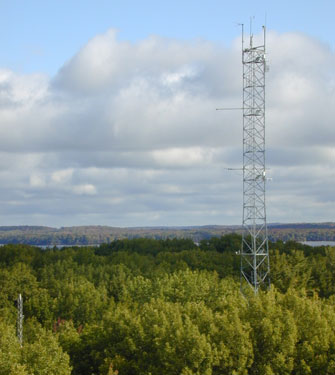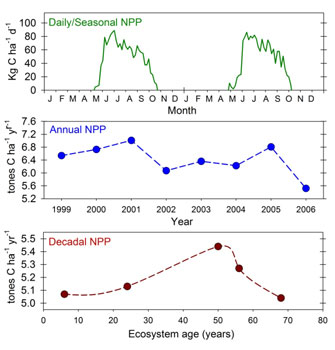By Knowledge Project, The Nature Education, No Date
Terrestrial ecosystems rely almost exclusively on the sun's energy to support the growth and metabolism of their resident organisms. Plants are quite literally biomass factories powered by sunlight, supplying organisms higher up the food chain with energy and the structural building blocks of life. Land plants, or autotrophs, are terrestrial primary producers: organisms that manufacture, through photosynthesis, new organic molecules such as carbohydrates and lipids from raw inorganic materials (CO2, water, mineral nutrients). These newly minted organic compounds lock up the sun's energy in chemical bonds, providing an energy currency accessible to heterotrophs, organisms that consume rather than produce organic molecules. In this way, primary producers are an essential vehicle for energy transfer from the sun to consumers, securing energy that can be passed from one consumer to another. The energetic and carbon-rich products of primary production supply consumers, including humans, with fuel to drive their metabolism while providing essential carbon-containing compounds that form the bricks and mortar of living cells.
Ecosystem ecologists have long been interested in two related metrics of terrestrial primary production. Gross primary production (GPP) is the total amount of carbon dioxide "fixed" by land plants per unit time through the photosynthetic reduction of CO2 into organic compounds. A substantial fraction of GPP supports plant autotrophic respiration (Ra), with the remainder allocated to the net primary production (NPP) of plant structural biomass in stems, leaves, and fruit, labile carbohydrates such as sugars and starch, and, to a much lesser extent, volatile organic compounds used in plant defense and signaling. Terrestrial GPP, therefore, relates to NPP as follows:
NPP = GPP - Ra

Figure 1: Net primary production (NPP) and standing biomass allocation for a 90-year-old Michigan forest estimated from inventory-based methods in which biomass growth is quantified over time (Gough et al.2008)
© 2011 Nature Education All rights reserved. 
Where do plants invest organic compounds designated for net primary production? Consider, as an example, a mature forest. The stems, leaves, flowers, and fruit are all visible displays of aboveground NPP (i.e., growth) that accrued over time — but what about belowground (root) NPP? Most of the NPP readily observed aboveground is matched in magnitude belowground by the less visible, but equally important, production of roots. For example, root growth comprised almost half of total ecosystem NPP in a ninety-year-old Michigan forest, indicating that belowground investments in biomass by plants are substantial (Figure 1). The total standing biomass of an ecosystem is a function of cumulative NPP over time minus biomass losses from senescence (i.e., death). In the same forest, stems (including trunks and branches) are the largest fraction of standing biomass, but roots comprise a quarter of the total biomass present in the ecosystem.
Measuring Gross and Net Primary Production

Figure 2: Meteorological towers like this one located in a temperate forest are distributed across ecosystems in all continents except Antarctica, providing assessments of carbon uptake by forest, grassland, desert, and crop ecosystems.
© 2011 Nature Education All rights reserved. 
Recent technological advances also allow for on-the-ground estimates of terrestrial primary production using meteorological towers that measure the uptake or emissions of CO2 by ecosystems (Figure 2). Meteorological towers measure net ecosystem CO2 exchange (NEE), which is equal to GPP minus ecosystem respiration or the quantity of CO2 respired by both autotrophs (plants) and heterotrophs (primarily microbes). GPP and NPP are calculated indirectly by adding ecosystem and heterotrophic respiration, respectively, to NEE. Meteorological approaches are employed worldwide in forest, agricultural, grassland, and desert ecosystems to track terrestrial primary production. For example, the international research network FLUXNET (Baldocchi et al.2001) supports observations of terrestrial primary production on six of seven continents.
At the global scale, satellite data combined with mathematical modeling is essential to providing worldwide estimates of terrestrial primary production. Several approaches have been used, but most notable are products derived from NASA's Moderate-resolution Imaging Spectroradiometer (MODIS), a satellite-mounted instrument that collects surface spectral, or color, data useful for tracking changes in the productivity of terrestrial and marine ecosystems. An example MODIS product is a "greenness" index of the Earth's surface used to estimate terrestrial primary production. Surface greenness and other remotely sensed data collected from space provide coarser assessments of NPP and GPP than inventory and meteorological tower based methods but have the advantage of providing estimates of terrestrial primary production for large areas where ground-based methods are not feasible.
Terrestrial Primary Production Over Time and Across the Earth's Surface

Figure 3: Patterns of terrestrial NPP at different timescales in a temperate forest: Daily net primary production (NPP) changes during the growing season in response to climate variables including solar radiation and precipitation, while the duration of NPP during the growing season (i.e., spring green-up to autumn leaf fall) is largely a function of photoperiod. Annual NPP changes from one year to the next in response to longer-term trends in climate, including shifts in total solar radiation caused by differences in cloud cover from year to year. Decadal patterns of NPP track changes in ecological succession (Gough et al. 2007, 2008).
© 2011 Nature Education All rights reserved. 
Over decades, a period that is meaningful to ecological succession, terrestrial primary production changes in response to shifts in plant competition and disturbance. Consider an abandoned field that undergoes a successional reversion back to forest. Plant communities will assemble during early succession, with fast-growing plants emerging first and because of low initial plant density there will be little competition for resources. As a result, total plant growth in the ecosystem, or NPP, will proceed at an increasingly higher rate for several years. NPP generally levels off or declines once plants start crowding one another and begin competing more intensively for limiting light, nutrient, and water resources (Figure 3). Terrestrial primary production also may change over time in response to natural disturbances such as insect outbreaks, wind, fire, and pathogens that diminish photosynthesis by reducing leaf biomass and causing plant death. Long-term increases in atmospheric CO2 and nitrogen deposition associated primarily with fossil fuel burning generally increase plant growth over long periods of time.
Terrestrial primary production varies considerably across the surface of the Earth and among different ecosystem types. Terrestrial primary production, both NPP and GPP, vary from north to south (or latitudinally) due to gradients in plant community composition, growing season length, precipitation, temperature, and solar radiation. However, east to west (longitudinal) differences in terrestrial primary production also exist. These spatial differences are illustrated in a map of global NPP derived from NASA's MODIS satellite (Figure 4). For example, there is a precipitous decline in NPP from east to west in middle North America that is largely a function of declining precipitation. NPP generally declines from tropical regions to the poles because of temperature and light limitations. Tropical forests tend to be much more productive than other terrestrial ecosystems, with temperate forests, tropical savannah, croplands, and boreal forests all exhibiting middle levels of primary production (Table 1). Desert and Tundra Biomes, limited by precipitation and temperature respectively, contain the least productive ecosystems. In addition to climatic regulation of terrestrial primary production, disturbance, management, and land-use change (including urbanization) play critical roles in determining spatial differences in terrestrial primary production.

Figure 4: The global distribution of land and ocean net primary production (NPP) estimated from spectral data gathered by NASA's MODIS satellite
Public Domain NASA Earth Observatory.
Tropical ecosystems, because of their high productivity and extensive footprint on the Earth's surface, comprise nearly half of global NPP and GPP (Table 1). Temperate ecosystems and croplands are also a substantial fraction of global terrestrial primary production, accounting for roughly a quarter of global NPP and GPP. Global estimates of terrestrial NPP range from 48.0 to 69.0 Pg (= Petagrams or 1015 g) C yr-1, with global terrestrial GPP estimated at 121.7 Pg C yr-1 or approximately double global NPP on land.
| Biome | Global GPP1 (Pg C yr -1) | Global NPP2 (PG C yr-1) | Ecosystem NPP3 (g C ha-1 yr |
| Tropical forest | 40.8 | 16.0–23.1 | 871–1098 |
| Temperate forest | 9.9 | 4.6–9.1 | 465–741 |
| Boreal forest | 8.3 | 2.6–4.6 | 173–238 |
| Tropical savannah and grasslands | 31.3 | 14.9–19.2 | 343–393 |
| Temperate grasslands and shrublands | 8.5 | 3.4–7.0 | 129–342 |
| Deserts | 6.4 | 0.5–3.5 | 28–151 |
| Tundra | 1.6 | 0.5–1.0 | 80–130 |
| Croplands | 14.8 | 4.1–8.0 | 288–468 |
| TOTAL | 121.7 | 48.0–69.0 | 2377–3561 |
Table 1: Global and ecosystem-scale estimates of mean terrestrial gross and net primary production for the Earth's major biomes from remotely sensed satellite data and modeling students. 1 Petagram (Pg) = 1015 grams (g).
1. Beer et al. 2000; 2. Melillo et al. 1993; Potter et al. 1993; Prince & Goward 1995; Field et al. 1998; Beer et al. 2010 3. Melillo et al. 1993; Potter et al. 1993; Prince & Goward 1995
| |||
Haberl et al. (2007) estimated that nearly a quarter of global NPP is used by humans annually in the production of crops for food and fiber, timber for wood products and paper, and in support of livestock grazing. Humans exert an additional influence on global NPP through fires. Many ecologists are concerned that the rising global demand for biofuels, together with continued human population growth, will increase this already large human appropriation of global NPP to the detriment of ecological food webs and biodiversity.
Terrestrial Primary Production and Global Change
Considerable research in ecosystem ecology centers on understanding how climate change is affecting the primary production of terrestrial ecosystems and, conversely, how ecosystems may moderate changes in global climate by absorbing anthropogenic CO2emissions. Terrestrial primary production is an important ecosystem service, locking up carbon in biomass that might otherwise exist in the atmosphere as CO2, a potent greenhouse gas. Recent evidence suggests, however, that terrestrial NPP may be declining in response to global warming and accompanying drought, with Zhoa & Running (2010) estimating a 0.55 Pg, or about 1%, reduction in global terrestrial NPP from 2000 to 2009. Continued declines in global NPP would not only reduce carbon sequestration by terrestrial ecosystems but also compromise food security and disrupt the foundation of food webs.
Summary
References and Recommended Reading
Baldocchi, D. et al. FLUXNET: A new tool to study the temporal and spatial variability of ecosystem-scale carbon dioxide, water vapor, and energy flux densities. Bulletin of the American Meteorological Society 82, 2415–2434 (2001).
Beer, C. et al. Terrestrial gross carbon dioxide uptake: Global distribution and covariation with climate. Science 329, 834–838 (2010).
Field, C. B. et al. Primary production of the biosphere: Integrating terrestrial and oceanic components. Science 281, 237–240 (1998).
Gough, C. M. et al. The legacy of harvest and fire on ecosystem carbon storage in a north temperate forest. Global Change Biology 13, 1935–1949 (2007).
Gough, C. M. et al. Controls on annual forest carbon storage: Lessons from the past and predictions for the future. Bioscience 58, 609–622 (2008).
Haberl, H. et al. Quantifying and mapping the human appropriation of net primary production in earth's terrestrial ecosystems. Proceedings of the National Academy of Sciences USA 104, 12942–12945 (2007).
Melillo, J. M. et al. Global climate-change and terrestrial net primary production. Nature 363, 234–240 (1993).
Potter, C. S. et al. Terrestrial ecosystem production - a process model-based on global satellite and surface data. Global Biogeochemical Cycles 7, 811–841 (1993).
Prince, S. D. & Goward, S. N. Global primary production: A remote sensing approach. Journal of Biogeography 22, 815–835. 1995.
Roy, J. et al. Terrestrial Global Productivity. San Diego, CA: Academic Press (2001).
Zhao, M. S. & Running, S. W. Drought-induced reduction in global terrestrial net primary production from 2000 through 2009. Science329, 940–943 (2010).

No comments:
Post a Comment